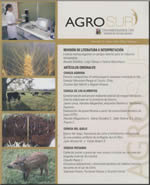PHENOTYPIC VARIABILITY IN ACCESSIONS OF Bromus valdivianus Phil
Main Article Content
Abstract
Bromus valdivianus Phil. is a native poaceae of South America. The objective of this study was to characterize 125 accessions of this species, collected in different areas of the Valdivia province in southern Chile and to analyze the phenotypic variability as a base for future breeding programmes. The accessions were collected from four regions of Valdivia province: NL (north central valley); NP (north foothills); SL (south central valley) and SP (south foothills). After germination in the laboratory the seedlings were transferred to the field. During summer, autumn and winter, 8 qualitative variables and 8 quantitative variables were evaluated. A complete randomized block design with four replicates was used. Variables evaluated in more than one period were subjected to split-plot analysis considering time and space. The data for the multivariate analysis were chosen according to the nature of the interaction between accession and season. When this interaction was significant, the variable was considered over three seasons; conversely, when the interaction was not significant the mean over the seasons was used. A total of 34 variables were obtained and subjected to principal component, cluster and discriminate analysis. Two principal components explained 51% of the total variation. The cluster analysis distinguished 6 groups. Two groups were clearly distinguished, one formed by accessions with good forage production features and another for its high seed yield. These results are useful for the selection of promissory material, for immediate utilization or for a breeding programme through progenitor selection.

